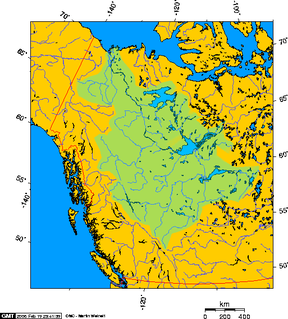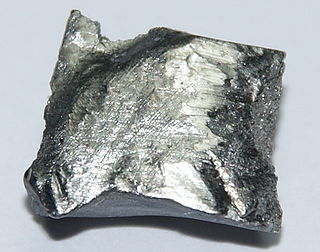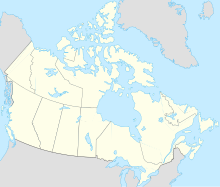
An ore is an occurrence of rock or sediment that contains sufficient minerals with economically important elements, typically metals, that can be economically extracted from the deposit. The ores are extracted from the earth through mining; they are then refined to extract the valuable element, or elements.

The mineral bastnäsite (or bastnaesite) is one of a family of three carbonate-fluoride minerals, which includes bastnäsite-(Ce) with a formula of (Ce, La)CO3F, bastnäsite-(La) with a formula of (La, Ce)CO3F, and bastnäsite-(Y) with a formula of (Y, Ce)CO3F. Some of the bastnäsites contain OH− instead of F− and receive the name of hydroxylbastnasite. Most bastnäsite is bastnäsite-(Ce), and cerium is by far the most common of the rare earths in this class of minerals. Bastnäsite and the phosphate mineral monazite are the two largest sources of cerium and other rare-earth elements.

Nepheline syenite is a holocrystalline plutonic rock that consists largely of nepheline and alkali feldspar. The rocks are mostly pale colored, grey or pink, and in general appearance they are not unlike granites, but dark green varieties are also known. Phonolite is the fine-grained extrusive equivalent.
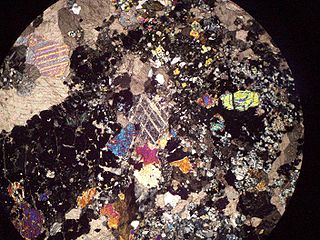
Skarns or tactites are hard, coarse-grained metamorphic rocks that form by a process called metasomatism. Skarns tend to be rich in calcium-magnesium-iron-manganese-aluminium silicate minerals, which are also referred to as calc-silicate minerals. These minerals form as a result of alteration which occurs when hydrothermal fluids interact with a protolith of either igneous or sedimentary origin. In many cases, skarns are associated with the intrusion of a granitic pluton found in and around faults or Shear zones that intrude into a carbonate layer such as a dolomite or limestone. Skarns can form by regional, or contact metamorphism and therefore form in relatively high temperature environments. The hydrothermal fluids associated with the metasomatic processes can originate from either magmatic, metamorphic, meteoric, marine, or even a mix of these. The resulting skarn may consist of a variety of different minerals which are highly dependent on the original composition of both the hydrothermal fluid and the original composition of the protolith.
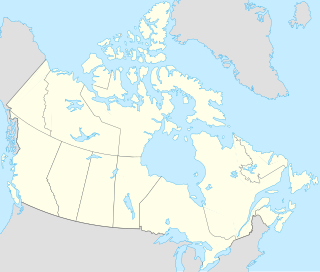
The Pine Point Mine is located on the south shore of Great Slave Lake between Hay River to the east and Fort Resolution to the west, in the Northwest Territories of Canada. It produced lead and zinc ores from a Mississippi Valley Type deposit between 1964 and 1988. Most of the mining was done by open-pit methods. The town of Pine Point was built by the mining company, Cominco, and when the mine closed the town was abandoned and demolished.

Lanthanites are a group of isostructural rare earth element (REE) carbonate minerals. This group comprises the minerals lanthanite-(La), lanthanite-(Ce), and lanthanite-(Nd). This mineral group has the general chemical formula of (REE)2(CO3)3·8(H2O). Lanthanites include La, Ce, and Nd as major elements and often contain subordinate amounts of other REEs including praseodymium (Pr), samarium (Sm), europium (Eu) and dysprosium (Dy). The lanthanite crystal structure consists of layers of 10-fold coordinated REE-oxygen (O) polyhedra and carbonate (CO32−) groups connected by hydrogen bonds to interlayer water molecules, forming a highly hydrated structure.
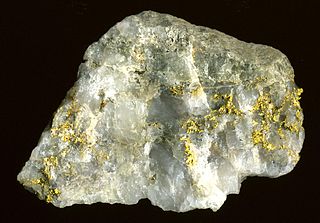
Various theories of ore genesis explain how the various types of mineral deposits form within the Earth's crust. Ore-genesis theories vary depending on the mineral or commodity examined.

A rare-earth mineral contains one or more rare-earth elements as major metal constituents. Rare-earth minerals are usually found in association with alkaline to peralkaline igneous complexes, in pegmatites associated with alkaline magmas and in or associated with carbonatite intrusives. Perovskite mineral phases are common hosts to rare-earth elements within the alkaline complexes. Mantle-derived carbonate melts are also carriers of the rare earths. Hydrothermal deposits associated with alkaline magmatism contain a variety of rare-earth minerals.
Uranium ore deposits are economically recoverable concentrations of uranium within the Earth's crust. Uranium is one of the more common elements in the Earth's crust, being 40 times more common than silver and 500 times more common than gold. It can be found almost everywhere in rock, soil, rivers, and oceans. The challenge is to find those areas where the concentrations are adequate to form an economically viable deposit.
Hoidas Lake is a remote northern Canadian lake which lies approximately 50 kilometers north of Uranium City, Saskatchewan. Named in honor of Irvin Frank Hoidas, a Royal Canadian Air Force pilot officer killed in action during the Second World War when his Stirling W-7520 crashed near the Belgian town of Saint-Truiden, it is the site of Canada's most advanced rare-earth element (REE) mining project.

Bayan'obo Mining District,, or Baiyun-Obo or Baiyun'ebo, is a mining town in the west of Inner Mongolia, People's Republic of China. It is under the administration of Baotou City, the downtown of which is more than 120 kilometres (75 mi) to the south.
Avalon Advanced Materials Inc. is a Canadian mineral development company with a primary focus on the rare metals and minerals, headquartered in Toronto, Ontario, Canada. Avalon specializes in niche market metals and minerals with growing demand in new technology. Avalon's principal assets are its 100% owned Nechalacho Project, Separation Rapids, East Kemptville, Nova Scotia, Lilypad Lakes, and Warren Township (Ontario).

The Ilimaussaq intrusive complex is a large alkalic layered intrusion located on the southwest coast of Greenland. It is Mesoproterozoic in age, about 1.16 Ga. It is the type locality of agpaitic nepheline syenite and hosts a variety of unusual rock types.

Kvanefjeld, in Greenland, is the site of a mineral deposit, which is claimed to be the world's second-largest deposit of rare-earth oxides, and the sixth-largest deposit of uranium. There are also substantial sodium fluoride deposits, and Kvanefjeld is thought to be one of the largest multi-element deposits of its kind in the world.
The Mineral Exploration Research Centre (MERC) is a semi-autonomous research centre associated with the Harquail School of Earth Sciences at Laurentian University in Sudbury Ontario, Canada, and one of the largest mineral exploration research-teaching clusters in the world. MERC is housed in the Willett Green Miller Mineral and Mining Research Centre on the Laurentian University campus, together with the Ontario Geological Survey, Ontario Geoscience Laboratories, John B. Gammon Mines Library, the administrative offices of the Minerals and Mining Division of the Ontari Ministry of Northern Development and Mines, MIRARCo, and Centre for Excellence in Mining Innovation.
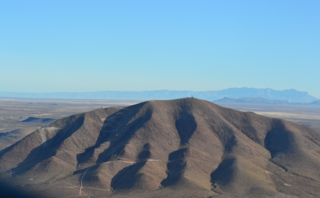
Round Top Mountain is a mountain that lies at the western end of the Sierra Blanca area in Hudspeth County, Texas near the town of Sierra Blanca, Texas. The area includes the Finlay Mountains, Triple Hill, and Sierra Blanca quadrangles as well as parts of the Fort Quitman and McNary quadrangles. Round Top Mountain is known for containing deposits of Beryllium as well as the largest deposit of heavy rare-earth elements in the United States.

Quartzolite or silexite is an intrusive igneous rock, in which the mineral quartz is more than 90% of the rock's felsic mineral content, with feldspar at up to 10%. Typically, quartz forms more than 60% of the rock, the rest being mostly feldspar although minor amounts of mica or amphibole may also be present. Quartzolite occurs as dykes, sills, veins, bosses and segregation masses. It is an extremely rare type of rock. No extrusive rock equivalent of quartzolite is known. Quartzolite is found in association with greisen and pegmatite.
Norra Kärr or Norra Kärr Alkaline Complex is an intrusive complex cropping out at the boundary between Östergötland and Småland, Sweden. The complex is chiefly made up of peralkaline nepheline syenite and is rich in exotic minerals. Rocks of the complex intruded into the Paleoproterozoic-aged Växjo granites of the Transscandinavian Igneous Belt. Alfred Elis Törnebohm was the first to describe the rocks of Norra Kärr in 1906. Norra Kärr was discovered a few years earlier during regional geological maping by the Swedish Geological Survey. The complex derives its name from a local farm, which translates into English as "Northern Fen". In 1968 Harry von Eckermann published his investigations on the complex defining its boundaries and confirming the view of it as an intrusion.

Regolith-hosted rare earth element deposits are rare-earth element (REE) ores in decomposed rocks that are formed by intense weathering of REE-rich parental rocks in subtropical areas. In these areas, rocks are intensely broken and decomposed. Then, REEs infiltrate downward with rain water and they are concentrated along a deeper weathered layer beneath the ground surface.
